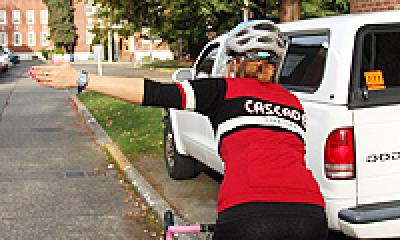Mastering a few basic bike handling skills will enhance your safety, efficiency, and enjoyment. Especially in traffic, riding predictably and confidently sends the message that you belong on the road. Here, we'll break down some basic bike handling skills into simple steps.
Cascade Bicycle Club offers a variety classes, including skills clinics that will boost your bike handling skills and confidence. Check out our upcoming offerings or learn how to bring these to your worksite.

A good start means setting off so that you are gradually increasing your speed, riding in a straight line, and maintaining stability.
1. Engage both brakes while you're stopped.
2. Position one pedal in the 2 o’clock "power position".
3. Transfer all your weight to this pedal; then release the brakes to set off.
4. Stand up on the pedal and simultaneously ease yourself back onto the saddle.
5. Keep your grip on the handlebars firm but relaxed so you will not wobble.
6. As you gain speed, shift to higher gears.
STOP safely
Stopping is arguably more important than going when it comes to safe riding. Stopping can also enhance your street cred.
1. Free one foot if you use toe clips, straps or clipless pedals.
2. To slow, apply both brakes evenly and gradually. Your dear old dad probably told you never to use your front brakes, but your front brakes actually accounts for 70% of your braking power. We'll address emergency stops (which can flip you over) in an upcoming column.
3. As you slow, shift down a few gears to make it easier to start up again.
4. Just as you come to a complete stop, turn the handlebars slightly. The bike will lean slightly, making it easier to step down.
5. Step down off the seat and put one foot down. You will find that one side is more natural than the other. Putting your foot down sends a clear message that you are stopping to other cyclists, motorists and law enforcement.
6. As you are stopped, reposition your pedal into the power position so that you are ready to start again.
RIDE in a straight line
This important skill may sound simple, but it is an essential aspect of riding predictably.
1. Use small adjustments of the handlebars and leaning your bike to correct your line.
2. Look up and ahead rather than staring at your front tire.
3. Do not weave in and out of parked cars as you ride along. Hold your line.
SCAN for traffic

Whether you are riding in traffic or on a trail, you need to be aware of and communicate with those around you. Scanning behind for overtaking traffic is especially crucial when merging or changing lanes. The trick is to maintain a straight line while looking over your shoulder.
1. Relax or remove the hand on the side you are scanning to avoid turning the handlebars as you scan. Some riders rest that hand on their thigh or hip.
2. Slightly tighten your grip on the other hand for balance and control.
3. Briefly turn your head to look over your shoulder to scan behind you. You may need to do this a few times.
A large part of riding predictably is letting others know what you plan to do before you do it. Hand signals are a vital communication tool. Always signal your intent when turning, changing lanes and changing position within the lane. This goes for bike lanes and trails, too.
There are actually two ways to signal a right turn, show below. Use the hand that is most visible to your audience. For example, if you want to merge from the center lane into the right lane, the alternative righthand signal would be most visible to those vehicles in the right lane.
| Left signal | Right signal | Alternative right signal |
|
Image
 |
Image
 |
Image
 |
Portions of this material are based on the League of American Bicyclists' Traffic Skills 101 © 2008
Share this post
